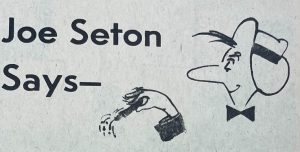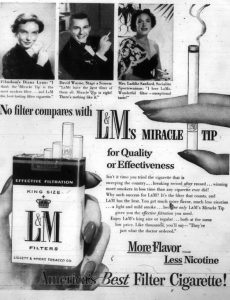I have felt so honored to read through the decade of issues of The Setonian. My life has been consumed by microfilm and old newspapers – college newspapers. I have been led on multiple paths. The Setonian weaved a collection of stories, all of which define common notions when studying the 1960s.
I marched down South Orange Avenue for a college newspaper in defense of freedom of speech. I witnessed the long-awaited arrival of women on a college campus that desperately needed them. I read news story after news story and was bombarded with advertisements – many of which were mundane, but a few were dangerous. Despite their danger, I trusted The Setonian to guide me. I watched Seton Hall experience the turbulent Sixties, gasped when they did, wept when they did, cheered when they did. I felt the pain and frustration of a student body who desperately wanted a break from reality through the sport of basketball but was denied. And I slept on a bus with Walter Dukes as he not only beat all other challengers in 1953 but Jim Crow as well.
I guess I should introduce myself. My name is Austin DelSontro. I am a senior at Seton Hall University. I majored in History, Political Science, and Philosophy, with a minor in Economics. The throughline for me between all these fields is the stories of people. That is why I was drawn to tell these stories. This is my Time Machines Project. In a sense, it is a literal time machine. It was my hope to take the reader back to the 1960s (and a little further than that) and retell certain stories of the time. Give the reader a glimpse into the past.
I have never written for The Setonian, something which I have come to regret terribly. I also was generally unaware of the importance of a college newspaper. Not only are college newspapers a very valuable piece of history, but, as I have come to learn, they also play an unbelievably important role in a college community.
The Setonian plays an incredible and necessary role in the everyday lives of students, even if they do not realize it. Reading The Setonian, a student can be introduced to happenings around campus that might not normally have been made known. The Setonian details sporting news, campus life, problems. The Setonian also gives the students a voice. The Setonian voices student displeasure with certain controversies as well as their important role in allowing student protests to be known.
This is not exclusive to the 1960s. The Setonian has continued to serve as a vehicle for students. Not simply trivial information but real knowledge. Knowledge that serves what a university ought to do: foster young minds. The Setonian acts as a vehicle to give power to the words of the youth. A recurring theme throughout my reading of The Setonian: apathy. Numerous editorials and columns condemn the existence of apathy from a student base. Again, this is not an exclusive problem of the 1960s or in an abstract historical sense. Apathy from youth continues to exist today. As the 1960s are indicative of, when the youth cares – when the youth really cares – radical change is possible.
On the first edition of The Setonian in 1924, the newspaper advised, “Get behind the paper, and it will live; neglect your duty and it will soon pass into oblivion.” Seton Hall has continually gotten behind the paper, despite our student body’s tendency for apathy. This paper is something students at Seton Hall care about.
Current editor-in-chief Emma Thumann stated, “Newspapers are part of the essential service of keeping the public informed of what is happening and how they may be affected. Student-run college newspapers, especially The Setonian, are no exception. Student journalism is journalism.” The Setonian exists as an organ for the student body by the student body.
The previous editor-in-chief Daniel O’Connor believed it was the job of The Setonian to remind Seton Hall of its purpose. On the very first issue, over a hundred years ago, The Setonian stated “the aim and purpose of The Setonian [is] to cultivate, nourish, and bring to fruition such loyalty and devotion to glorious Old Setonia and all she stands for.”
O’Connor believed The Setonian reminded Seton Hall of its purpose “in 1964 when President Rev. Dougherty suspended The Setonian for being too critical of administrative priorities.” Then also “in 2005 and 2015, after the school’s mistreatment of LGBT students and faculty.” Then again “in 2022, by students accusing their RAs of assault.” Throughout these events, it has been The Setonian guiding the campus.
The Setonian is not merely an informant for the students; it can also be a conduit for change, a guardian of transparency, and a champion of student voice. In every issue published, in every story told, it reaffirms its commitment to fostering an informed, reflective, and active campus culture. As Seton Hall, its many joys and challenges included, continues to navigate the complexities of the world, The Setonian stands as a testament to the power of student journalism in shaping the conscience of the university. In its pages, we find not only news but a call to action—a reminder of what the goal of higher education should be.
There are so many people I want to thank. From the Walsh Gallery employees, from Sarah Ponichtera to Jeanne Brasile to Quinn Christie to Jackie Deppe to Martha Slomczeweski to Stephen Bacchetta, to Dr. Sara Fieldston for advising my project to Dr. Dermot Quinn for his enlightening Seton Hall University: A History, 1856–2006 to all the editors of The Setonian past and present to my girlfriend Noelia for listening to my raving about newspapers from the 60s, this project could not have been possible without so many people.
I know this work will not be beyond reproach. There are sure to be a couple of errors. And I am aware that 1953 is not a part of the 1960s. However, this work serves as a collection of the ever-present themes found in the 1960s. An ever-important decade in bringing about change, not just at Seton Hall, nor just in the United States of America, but the entire world at large. Enjoy!





